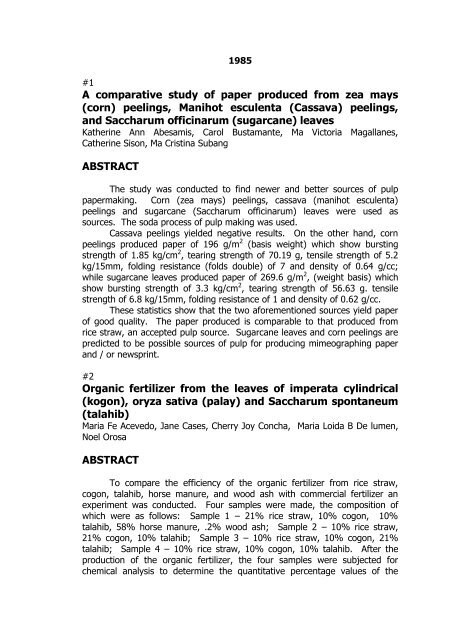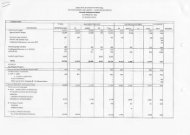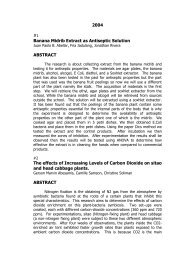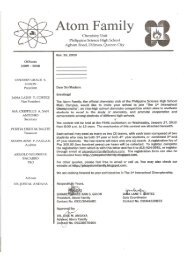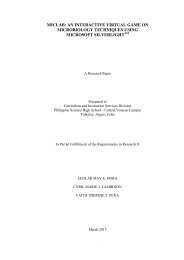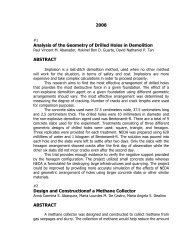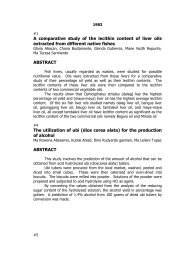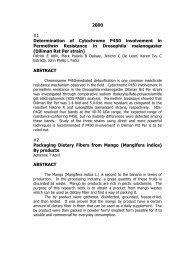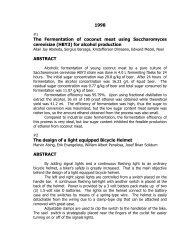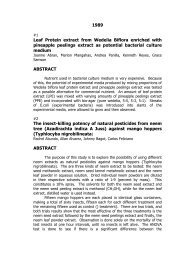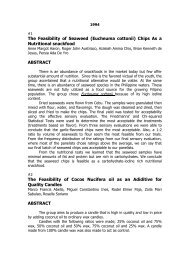A comparative study of paper produced from zea mays - Philippine ...
A comparative study of paper produced from zea mays - Philippine ...
A comparative study of paper produced from zea mays - Philippine ...
You also want an ePaper? Increase the reach of your titles
YUMPU automatically turns print PDFs into web optimized ePapers that Google loves.
1985<br />
#1<br />
A <strong>comparative</strong> <strong>study</strong> <strong>of</strong> <strong>paper</strong> <strong>produced</strong> <strong>from</strong> <strong>zea</strong> <strong>mays</strong><br />
(corn) peelings, Manihot esculenta (Cassava) peelings,<br />
and Saccharum <strong>of</strong>ficinarum (sugarcane) leaves<br />
Katherine Ann Abesamis, Carol Bustamante, Ma Victoria Magallanes,<br />
Catherine Sison, Ma Cristina Subang<br />
ABSTRACT<br />
The <strong>study</strong> was conducted to find newer and better sources <strong>of</strong> pulp<br />
<strong>paper</strong>making. Corn (<strong>zea</strong> <strong>mays</strong>) peelings, cassava (manihot esculenta)<br />
peelings and sugarcane (Saccharum <strong>of</strong>ficinarum) leaves were used as<br />
sources. The soda process <strong>of</strong> pulp making was used.<br />
Cassava peelings yielded negative results. On the other hand, corn<br />
peelings <strong>produced</strong> <strong>paper</strong> <strong>of</strong> 196 g/m 2 (basis weight) which show bursting<br />
strength <strong>of</strong> 1.85 kg/cm 2 , tearing strength <strong>of</strong> 70.19 g, tensile strength <strong>of</strong> 5.2<br />
kg/15mm, folding resistance (folds double) <strong>of</strong> 7 and density <strong>of</strong> 0.64 g/cc;<br />
while sugarcane leaves <strong>produced</strong> <strong>paper</strong> <strong>of</strong> 269.6 g/m 2 , (weight basis) which<br />
show bursting strength <strong>of</strong> 3.3 kg/cm 2 , tearing strength <strong>of</strong> 56.63 g. tensile<br />
strength <strong>of</strong> 6.8 kg/15mm, folding resistance <strong>of</strong> 1 and density <strong>of</strong> 0.62 g/cc.<br />
These statistics show that the two aforementioned sources yield <strong>paper</strong><br />
<strong>of</strong> good quality. The <strong>paper</strong> <strong>produced</strong> is comparable to that <strong>produced</strong> <strong>from</strong><br />
rice straw, an accepted pulp source. Sugarcane leaves and corn peelings are<br />
predicted to be possible sources <strong>of</strong> pulp for producing mimeographing <strong>paper</strong><br />
and / or newsprint.<br />
#2<br />
Organic fertilizer <strong>from</strong> the leaves <strong>of</strong> imperata cylindrical<br />
(kogon), oryza sativa (palay) and Saccharum spontaneum<br />
(talahib)<br />
Maria Fe Acevedo, Jane Cases, Cherry Joy Concha, Maria Loida B De lumen,<br />
Noel Orosa<br />
ABSTRACT<br />
To compare the efficiency <strong>of</strong> the organic fertilizer <strong>from</strong> rice straw,<br />
cogon, talahib, horse manure, and wood ash with commercial fertilizer an<br />
experiment was conducted. Four samples were made, the composition <strong>of</strong><br />
which were as follows: Sample 1 – 21% rice straw, 10% cogon, 10%<br />
talahib, 58% horse manure, .2% wood ash; Sample 2 – 10% rice straw,<br />
21% cogon, 10% talahib; Sample 3 – 10% rice straw, 10% cogon, 21%<br />
talahib; Sample 4 – 10% rice straw, 10% cogon, 10% talahib. After the<br />
production <strong>of</strong> the organic fertilizer, the four samples were subjected for<br />
chemical analysis to determine the quantitative percentage values <strong>of</strong> the
different nutritive components <strong>of</strong> the samples. Sample 1 had the following<br />
composition: .36% Nitrogen, .28% Phosphorus, .38% Potassium, 8.65%<br />
moisture. For sample 2, the following values were obtained: .33% Nitrogen,<br />
.16% Phosphorus, .39% Potassium, 6.56% moisture. For sample 3, had the<br />
following composition : .30% Nitrogen, .24% Phosphorous, .46% Potassium<br />
and 5.85% moisture. Sample 4 was as follows: .40% Nitrogen, .52%<br />
Phosphorous, .44% Potassium and 6.30% moisture.<br />
The group chose tomato as the experimental plant because <strong>of</strong> its<br />
availability, its relatively short maturation period, and most important, its<br />
need for nutrients such as Nitrogen, phosphorus, and potassium, otherwise<br />
known by their atomic symbols N-P-K.<br />
#3<br />
The phytochemical screening and microbiological assay <strong>of</strong><br />
“Philodendron laceron” (toothed Philodendron)<br />
Joel M Addawe, Marie Patricoa G Casiño, Dorinda S Doroja, Theodore D<br />
Erguiza, Sharon C Lopez<br />
ABSTRACT<br />
This research project is aimed at determining the phytochemical<br />
properties <strong>of</strong> the leaves <strong>of</strong> Philodendron leacerum. The phytochemical<br />
screening which was done on the ethanolic extract <strong>of</strong> the plant’s leaves<br />
showed that alkaloids, quarternary and / or amine oxide bases and<br />
polyphenolic compounds were present.<br />
Using <strong>paper</strong>-disc diffusion method, the ethanolic extracts were tested<br />
for their inhibitory effects against S cerevisiae, Eschrichia coli, Mycobacterium,<br />
Fusarium monoliforme, and Rhizopus arrhizus. The extracts showed no<br />
substantial inhibitory activities against these microorganisms.<br />
#5<br />
Nutritive content <strong>of</strong> Mangifera indica (mangga) leaves<br />
Ma Emilita Marcia Aguilar, Jennifer Emilie Gache, Frederick Ulpiano Pontillas,<br />
Anna Lourdes San Luis<br />
ABSTRACT<br />
Mango leaves are known to be used by barrio folk in dishes such as<br />
kilawin, sinigang and pinangat. This <strong>study</strong> has determined the basic nutritive<br />
constituents <strong>of</strong> mango leaves using proximate analysis. The mature leaves<br />
were found to contain nutrient in the following amounts: crude fat, 5.32%;<br />
crude fiber, 7.866%; moisture, 58.1265%; ash 6.465%; carbohydrates,<br />
22.2%; protein, only a trace. On the other hand, the young leaves were<br />
found to contain nutrients in the following percentages: crude fat, 2.125%;<br />
crude fiber, 4.43%; moisture, 78.5385%; ash, .17%; carbohydrates,<br />
14.7365%; protein, just a trace, too. The relatively high carbohydrate, fiber<br />
and fat content <strong>of</strong> the leaves make them a feasible feed supplement for
animals or as roughage. However, the very low protein content <strong>of</strong> the leaves<br />
makes the leaves an impractical food source for humans.<br />
#6<br />
Phytochemical screening and microbiological assay <strong>of</strong><br />
Averrhoa bilimbi (kamias) roots<br />
Armando Agulan Jr, Lester Ecarma, Francisco Ignalaga, francis Yabut<br />
ABSTRACT<br />
The research project aimed to determine the phytochemicals present in<br />
the roots <strong>of</strong> Averrhoa bilimbi (kamias) and the anti-microbial properties <strong>of</strong> its<br />
ethyl alcohol, ethyl acetate, hexane and water extracts as tested against the<br />
fungus, A fumigatus, and bacteria which were E coli, M Luteus S aureus and B<br />
subtilis.<br />
Results showed that kamias roots contain all the phytochemicals<br />
except anthraquinones and flavonoids. All the extracts showed zones <strong>of</strong><br />
inhibition in the five microorganisms.<br />
#7<br />
Proetien enrichment <strong>of</strong> banana (musa sapientum var.<br />
lakatan) juice using mungbeans (phaseolus aureus)<br />
Vincent Agunod, Chrysogonus Fernandez, Nestor Magkawas Jr, Angelo Palo,<br />
Rhett Emmanuel Serfino<br />
ABSTRACT<br />
This <strong>study</strong> involves the production <strong>of</strong> a protein enriched fruit beverage<br />
using the juices <strong>of</strong> the banana (musa sapientum var. lakatan) and the protein<br />
extracts <strong>of</strong> mungbeans (phaseolus aureus).<br />
The project has five major stages. There are : protein extraction,<br />
acidification <strong>of</strong> protein extract, juice extraction, combination/adjustment, and<br />
evaluation <strong>of</strong> the finished product.<br />
The protein content was analyzed using the Kjeldahl method. Three<br />
trials were conducted on both the pure protein extract and the finished<br />
product. The protein content <strong>of</strong> the pure protein extract was measured to be<br />
3.1%, while the protein content <strong>of</strong> the finished product was found to be at<br />
3.0%.<br />
To test the commercial appeal <strong>of</strong> the drink, the finished product was<br />
compared to a commercial drink and subjected to Sensory Evaluation tests.<br />
The results <strong>of</strong> these tests were tabulated and analyzed statistically using the<br />
chi-square and the Friedmann’s Test. The results <strong>of</strong> the latter show that with<br />
regards to General Acceptability and taste, the null hypothesis which states<br />
that there is no significant difference between the two drinks should be<br />
accepted. However, texture, odor and color <strong>of</strong> the banana juice has yet to<br />
undergo improvements.
The results <strong>of</strong> the Chiu-Square show that although more people would<br />
rather purchase the commercial drink, the difference is statistically<br />
insignificant.<br />
#8<br />
The chemical analysis <strong>of</strong> the nutritive content <strong>of</strong> terminalia<br />
catappa fruitpericarp and nut<br />
Edilberto Alcanzare, Sheryll Baranda, Wilfredo Manuela, Cesar Guinto, John<br />
Ysrael Baluyut<br />
ABSTRACT<br />
The <strong>study</strong> involved a proximate analysis <strong>of</strong> the fruit’s nutritive content.<br />
The values obtained were then compared with common food sources.<br />
The edibled portion <strong>of</strong> the talisai fruit frut are 57% and 5% for its<br />
pericarp and nuts respectively. The fruit’s pericarp is composed <strong>of</strong> 90.35%<br />
moisture, 0.20% crude fiber, 0.06% ash, 1.05% protein, 4.31% fat and<br />
4.03% carbohydrate. For the nut, its composition is as follows: 34.100%<br />
moisture, 2.38% crude fiber, 3.34% ash, 2.11% protein, 35.30 fat and<br />
22.77% carbohydrate.<br />
The nut has a higher nutritive value compared to the pericarp and is<br />
therefore a better food source.<br />
#9<br />
Feasibility <strong>of</strong> carica papaya trunk and leaves as a source <strong>of</strong><br />
<strong>paper</strong> pulp<br />
Jesus Almendral, Dionisio Diokno III, Albert Palima, Edwin Rodriguez, Virgil<br />
Saldajeno<br />
ABSTRACT<br />
Soda pulps obtained <strong>from</strong> the leaves and trunk <strong>of</strong> Carica papaya<br />
(papaya) were subjected to a quantitative chemical analysis. Results were<br />
then compared with standards to determine whether such pulps are suitable<br />
for <strong>paper</strong>making.<br />
Results are as follows: leaves: 7.26% ash, 21.65% pentosan, 58.82%<br />
alpha-cellulose, 18.63% solubility in 1% NaOH; Trunk: 35.8% ash, 25.83%<br />
pentosan, 68.72% alpha-cellulose, 24.4% solubility in 1% NaOH. Standards<br />
are: less than .15% ash, 2-20% pentosan, more than 85% alpha-cellulose,<br />
less than 15% solubility in 1% NaOH.<br />
The pulps <strong>from</strong> the leaves and trunks <strong>of</strong> carica papaya are not good<br />
<strong>paper</strong> pulps due to the high ash and pentosan content, low- cellulose content,<br />
and high solubility in 1% NaOH.
#10<br />
The feasibility <strong>of</strong> langka (Artocarpus heterophyllus) seeds<br />
as a source <strong>of</strong> flour<br />
Vincent Aluquin, Elmer Astillero, Hernando Ombao, Jarvis Punsalan, Victor<br />
Sicam<br />
ABSTRACT<br />
Langka (Artocarpus heterophyllus) thrives in almost every part <strong>of</strong> the<br />
country. The fruit contains abundant seeds which are edible. It is known<br />
that langka seeds are rich in carbohydrates and its components are similar to<br />
wheat in similar percentages.<br />
The <strong>study</strong> were boiled and peeled <strong>of</strong> its outer coverings. It was then<br />
sundried, and ground using the Wiley mill. Langka seed flour together with<br />
wheat flour in different percentages was then cooked using tortillo chips as<br />
recipe.<br />
The sensory Evaluation test results showed that langka seed flour is<br />
feasible enough to substitute wheat flour in terms <strong>of</strong> production cost and<br />
general acceptability especially in the 20:80 langka-wheat flour ratio.<br />
11<br />
Leaf protein concentrates <strong>from</strong> tridax procumbens (wild<br />
daisy) as meat protein substitute<br />
Aileen A Apolinario, Ma Celia L Arguelles, Rupert Erwin G Exconde, Norberto R<br />
Marquez, Rheniland F Mendoza<br />
ABSTRACT<br />
The leaves <strong>of</strong> Tridax procumbens (wild daisy) were utilized as sources<br />
<strong>of</strong> protein concentrates. The leaf protein concentrates <strong>from</strong> the<br />
aforementioned plant was prepared on a laboratory scale using the heat<br />
coagulation method <strong>of</strong> extraction. The coagulum was dried and incorporated<br />
into hamburgers at different levels <strong>of</strong> substitution (25% and 50%). Both<br />
preparations were found to be minimally acceptable with the 25%<br />
substitution being more acceptable than the 50% substitution.<br />
Tridax procumbens leaf protein concentrates not viable as a meat<br />
protein substitute.
#12<br />
Proximate analysis <strong>of</strong> pleurotus ostreatus (Abalone<br />
mushroom)<br />
John Thomas A Aquino, Salvador T Bernardo Jr, Romig J Celis, Eric Manuel N<br />
Pareja, Warren David A Sarmiento<br />
ABSTRACT<br />
This experiment was designed in order to determine the actual<br />
nutritive value <strong>of</strong> the Pleurotus ostreatus more commonly referred to as the<br />
abalone mushroom.<br />
Our experiment required four separate samples <strong>of</strong> the Abalone<br />
mushroom – one air-dried and three oven-dried samples. These samples<br />
were made to undergo specific tests and preparations for the determination<br />
<strong>of</strong> the following: To ash, to moisture, to rude fiber, % protein, % fat. The<br />
Abalone mushroom was found to cantain89.5% moisture, 2.91% protein,<br />
0.49% ash, 0.16 crude fat, 1.17% crude fiber and 5.72% carbohydrates. It is<br />
preferable to store the mushrooms in their dry form. The experiment also<br />
sought to determine in what form the Abalone mushroom could best be<br />
appreciated. Two <strong>of</strong> the suggested forms were: as a meat extender; and as<br />
bouillon cubes for soup. Unfortunately, however, due to our slow pace and<br />
lack <strong>of</strong> time, not all possible forms were explored.<br />
#13<br />
A <strong>study</strong> on the capability <strong>of</strong> Bacillus polymyxa and<br />
azespirillum lip<strong>of</strong>erum I protecting tomato plants <strong>from</strong><br />
wilt disease<br />
Anna Melissa Aspiras, Delia Bobadilla, Gladys Cherisse Completo, Annete<br />
Domingo, Ma Alexandra Pura<br />
ABSTRACT<br />
Pseudomonas solanacearum is a serious disease causing agent <strong>of</strong><br />
solanaceous plants such as tomato, pepper, tobacco, and Irish potato. The<br />
beneficial bacteria, Bacillus polymyxa and Azespirillium lip<strong>of</strong>erum, are both<br />
nitrogen fixers. These bacteria were used to demonstrate the idea that by<br />
pre-emptive colonization, the beneficial bacteria can prevent the entry <strong>of</strong><br />
harmful bacteria into some plants. Therefore, it is a mechanism <strong>of</strong> discrete<br />
preventions.<br />
In the treatment with the bacteria B polymyxa and P solanacearum,<br />
0%, 8.7%, and 40% were the casualties or the percentage <strong>of</strong> its mortality<br />
rate in the three trials. In the treatments with the bacteria A lip<strong>of</strong>erum and P<br />
solanacearum, 0%, 1.4%, and 10% were the casualties, also, in the three<br />
trials. While, in the treatment with P solanacearum alone, 6.7% 35%, and<br />
70% <strong>of</strong> the original populations died because <strong>of</strong> the wilt disease.
With regards to the heights <strong>of</strong> the plants, a common behavior or trend<br />
sites that plants with the harmful bacteria alone had the shortest average<br />
heights while the heights <strong>of</strong> the other plants treated with B polymyxa or A<br />
lip<strong>of</strong>erum. However, the t-test and x2 – test done showed insignificant<br />
results, which means that there are no significant differences among the four<br />
treatments in terms <strong>of</strong> mortality rates and heights <strong>of</strong> the plants.<br />
#14<br />
Charcoal oven<br />
Rolito Asuncion, Josef Bringas, Rodolfo Ibanez, Noel Tiangco, Emilio Vergara<br />
III<br />
ABSTRACT<br />
The researchers aim to construct a charcoal oven with the same<br />
capabilities as that <strong>of</strong> a commercial oven. Materials used were galvanized<br />
iron sheets, rivets, grille, aluminum sheet, wire mesh and rice hull ask (as an<br />
insulator). Tests were conducted to determine the performance <strong>of</strong> the oven.<br />
The maximum temperature obtained was 290 C. The results obtained for<br />
cooking a pizza pie was seven (7) minutes. Roasting half a chicken took one<br />
(1) hour.<br />
The results proved to be very promising. Further research might<br />
produce a more effective oven.<br />
#15<br />
Utilization <strong>of</strong> leaf protein concentrates <strong>from</strong> Cucurbita<br />
maxima and peperomia pellicida for human consumption.<br />
Alvin Atenido, Christopher Baylon, Jacinto Gabriel. Gregorio Galve,<br />
Rosemarivic Villen<br />
ABSTRACT<br />
The utilization <strong>of</strong> cucurbita maxima (kalabasa) and peperomia pellucida<br />
(ulasiman bato) leaves as sources <strong>of</strong> protein concentrates was investigated<br />
and studied upon. Leaf protein concentrates (LPC) <strong>of</strong> the two plants<br />
mentioned were prepared on a laboratory scale and were extracted with the<br />
use <strong>of</strong> the heat coagulation method. The protein concentrations <strong>of</strong> the LPCs<br />
were determined with the use <strong>of</strong> the Kjedahl process and were found to be<br />
31.98% and 26.65% for C maxima and P pellucida respectively. The LPCs<br />
were found to contain essential amino acids. The LPCs <strong>of</strong> both leaves were<br />
incorporated into rice cake (biko) to enrich it. Sensory evaluation tests were<br />
done on the rice cake. Fortifications up to 4.8% <strong>of</strong> both LPCs were found to<br />
be acceptable with the C maxima LPC fortified “biko” being highly acceptable.
#16<br />
The protein content and the potential antagonistic<br />
property <strong>of</strong> alphitobius laevegatus (black fungus bettle)<br />
Melflor Atienza, Levi Fernadez, Corazon de Ungria, Lemuel De Velez, Monica<br />
Xavier<br />
ABSTRACT<br />
The objective <strong>of</strong> the <strong>study</strong> are to find the protein content and to<br />
determine the antagonistic property <strong>of</strong> alphitobius laevegatus (black fungus<br />
beetle). The Kjeldahl method for quantitative protein analysis showed that<br />
the beetle contains 14% protein. This is comparable to the protein found in<br />
locust (13.7), squid (14%), and pork liver (19.7%).<br />
To test the antagonistic (dilating) property <strong>of</strong> A laevegatus, an isolated<br />
tissue experiment using the tracheal muscle <strong>of</strong> the cat was performed.<br />
Acetylcholine was used as the contracting agent and atropine and epinephrine<br />
as the control antagonists (dilators). When the beetle extract was added, no<br />
visible antagonistic effect was observed.<br />
#17<br />
Feasibility <strong>study</strong> <strong>of</strong> using pineapple (Ananas comosus<br />
Merr.) peelings as pulp for <strong>paper</strong>making<br />
Roelito A Begnotea, Ariel M Borja, Glenn Y Guevarra, Jansen S Lorena<br />
ABSTRACT<br />
The peelings was subjected to drying (preferably oven drying). The<br />
initial weight <strong>of</strong> the samples was 1 kg. And was reduced to 600 grams after<br />
oven drying. The samples were cooked in caustic soda or sodium hydroxide<br />
following the soda process <strong>of</strong> pulping. The pulp was bleached using the C-E-<br />
H process. The sheets were formed by molding the pulp in silkscreen.<br />
The outcome <strong>of</strong> the experiment is a yellowish <strong>paper</strong> with a bursting<br />
strength <strong>of</strong> 6.47; tearing strength <strong>of</strong> 16.89; breathing length <strong>of</strong> 3720.72;<br />
double folds <strong>of</strong> 1.0; tensile strength <strong>of</strong> 8.5. The density was calculated to be<br />
0.82 and the weight to be 3.70.<br />
The <strong>paper</strong> was confirm to be an ideal material for use as Bristol and<br />
<strong>paper</strong>board.
#18<br />
Feasibility <strong>of</strong> salvinia molesta as feed supplement for<br />
gallus gallus (chicken)<br />
Gary A Bogarin, Denver M Gomez, Emmelyne C Lita, Judy G Lopez, Amaya B<br />
Mata<br />
ABSTRACT<br />
This experiment tested the efficiency <strong>of</strong> Salvinia molesta as feed<br />
supplement on 22 chicks. There were four groups fed with different ratios <strong>of</strong><br />
salvinia molesta mixed with the commercial feed, broiler mash. Varying<br />
treatments <strong>of</strong> salvinia molesta were given --- 10 % Salvinia molesta, 20%<br />
Salvinia molesta, 30% Salvinia molesta and 100% broiler mash served as the<br />
control. Results <strong>of</strong> the research indicated that among the experimental<br />
groups, the chicks fed with 20% Salvinia molesta had the greatest gain in<br />
weight. They were significantly heavier and required the least amount <strong>of</strong><br />
feed. In addition, the chicks fed with 20% Salvinia molesta mixed with 80%<br />
commercial broiler had the greatest performance efficiency. Thus, the 29%<br />
Salvinia molesta is the optimum concentration needed to produce an efficient<br />
feed for chicken.<br />
#19<br />
Protein <strong>from</strong> leucaena leucocephala (ipil-ipil) leaves as a<br />
component <strong>of</strong> a sensitizer<br />
Ma Brenda E Carbonilla, Ma Teresa A Cuison, Jojo-Anne A Guzman, Rosanna<br />
M Roy, Elizabeth S Sanchez<br />
ABSTRACT<br />
Protein <strong>from</strong> young ipil-ipil leaves was extracted and isolated through<br />
the heat coagulation method, and incorporated with ammonium dichromate<br />
and ammonium hydroxide to produce a sensitizer used in a lithographic work<br />
called platemaking. A sensitizer is a colloidal solution <strong>of</strong> protein an<br />
ammonium dichromate which, when dried down on any surface, becomes<br />
sensitive to light. Ipil-ipil sensitizers were prepared to test the suitability <strong>of</strong><br />
ipil-ipil protein as component <strong>of</strong> a sensitizer. Five ipil-ipil sensitizers <strong>of</strong><br />
different ammonium dichromate-leaf protein concentrate ratios were tested in<br />
platemaking, along with a commercial sensitizer. Results showed that ipil-ipil<br />
sensitizers <strong>of</strong> 1:4 and 1:5 ratios were <strong>of</strong> the same efficiency as the<br />
commercial sensitizer. The final results attested the suitability <strong>of</strong> ipil-ipil<br />
protein as a component <strong>of</strong> sensitizers used in platemaking, and as a suitable<br />
substitute for casein or albumin, the proteins commonly used in sensitizers.
#21<br />
A <strong>comparative</strong> <strong>study</strong> on the efficiency <strong>of</strong> carabo dung and<br />
ipil-ipil leaves as substitute for charcoal<br />
Sheryl Catura, Lorna de Leon, Dolores Dimapilis<br />
ABSTRACT<br />
This <strong>study</strong> tested the efficiency <strong>of</strong> two materials as charcoal<br />
substitutes. Ipil-ipil leaves and carabao dung were decayed on separate pits<br />
for 45 days. Then mixed into proportions <strong>of</strong> : 100% dung, 100% ipil-ipil<br />
leaves and 50% dung plus 50 % ipil-ipil leaves for molding in briquettes. The<br />
briquettes were allowed to dry for 1 day. Efficiency was tested by heating<br />
150 ml <strong>of</strong> water.<br />
Temperature <strong>of</strong> the water was taken at 2 min, intervals, and the<br />
maximum temperature <strong>of</strong> water was recorded when the charcoal substitute<br />
was used up. Each treatment received 6 trials, using 3 briquettes per trial.<br />
Ordinary charcoal was subjected to the same test, and the results were used<br />
as a basis <strong>of</strong> comparison. The results <strong>of</strong> the test and by using the Analysis <strong>of</strong><br />
variance (ANOVA) test showed that dung-ipil mixture was the most efficient<br />
charcoal substitute.<br />
#22<br />
The Production <strong>of</strong> glue and <strong>paper</strong> <strong>from</strong> scrap hides<br />
Neriza Y Chin, Evelyn Angelita P Curioso, Rowena B Gobenciong, Maria Alyn<br />
Ines J Newman, Margaret S Yenko<br />
ABSTRACT<br />
The research work aimed to determine the possibility <strong>of</strong> producing glue<br />
and <strong>paper</strong> <strong>from</strong> scrap hides.<br />
For the production <strong>of</strong> glue, alum was added to the extract <strong>produced</strong><br />
<strong>from</strong> the boiling <strong>of</strong> scrap hides. As for the production <strong>of</strong> <strong>paper</strong>, the pulp was<br />
not subjected to quantitative test. It was immediately processed into <strong>paper</strong><br />
by hand <strong>paper</strong>making.<br />
The glue <strong>produced</strong> developed into a heterogeneous mixture <strong>of</strong> a<br />
crystalline substance and the liquid which did not exhibit sufficient adhesive<br />
properties on wood or <strong>paper</strong>. On the other hand, the <strong>paper</strong> <strong>produced</strong><br />
exhibited a tearing strength (58.0g) within the range <strong>of</strong> <strong>Philippine</strong> standards<br />
for wrapping <strong>paper</strong> but was substandard in terms <strong>of</strong> thickness (35.71 mills)<br />
and weight (419.0 kg/15mm). It did not pass any <strong>of</strong> the standards for writing<br />
<strong>paper</strong>.
#23<br />
Rice cakes incorporated with leaf protein in concentrates<br />
<strong>from</strong> moringa oleifera<br />
Ronilda A Covar, Ma Lourdes L Dario, Ramonia M Gerona, Romeo G Lasam Jr,<br />
Miriam Ruth B Marzan<br />
ABSTRACT<br />
Moringa oleifera, which is more commonly known as malunggay, was<br />
utilized as a possible source <strong>of</strong> leaf protein concentrates. Leaf protein<br />
concentrates <strong>of</strong> this plant were prepared in the laboratory using the beat <strong>of</strong><br />
the LPC extracted using the salt-coagulation method was found to be 17.85%<br />
while that <strong>of</strong> the heat-coagulated LPC was 25.0%. This indicates the<br />
advantage <strong>of</strong> the heat-coagulation in LPC extraction over the other method.<br />
The LPC’s were also found to contain aromatic, sulfur-containing and indolegroup<br />
containing amino-acids which are some <strong>of</strong> the essential amino acids.<br />
The LPC was incorporated into rice cakes, a protein-deficient food<br />
preparation. From the sensory evaluation test done on the rice cakes, it was<br />
found that fortification up to about 3% was equally acceptable as the sample.<br />
This means that LPC’s can be utilized as a protein-supplement for protein<br />
deficient food preparations like puto.<br />
#27<br />
Proximate analysis <strong>of</strong> caesalpina pulcherrima (caballero)<br />
Michael Gaston, Nathaniel Bacareza, Andrew Eric Garingalao, Eliseo Segui,<br />
Remus Villanueva<br />
ABSTRACT<br />
The legume Caesalpina pulcherrima commonly known as caballero,<br />
was analyzed to determine its potential as a source <strong>of</strong> high-protein feedstuff<br />
for implementation in the poultry and livestock industry. Proximate analysis<br />
was used to determine the quantitative percentage values <strong>of</strong> the different<br />
nutritive components <strong>of</strong> the leaves <strong>of</strong> the plant. Caesalpina pulcherrima had<br />
the following composition: 63.50% moisture, 18.96% carbohydrates. Based<br />
on known composition <strong>of</strong> feeds already being used, Caesalpina pulcherrima<br />
may used as a feed supplement for poultry and livestock.
#28<br />
The device to harness th mechanical energy released<br />
during the deceleration <strong>of</strong> an automobile<br />
Giselle G Gervacio, Elma S Dizon, Yvonne R Pineda, Emmeline G Cadabes,<br />
Geneva M Selirio<br />
ABSTRACT<br />
The <strong>study</strong> deals with the construction <strong>of</strong> a fuel economizer which<br />
works by reutilizing the harnesses mechanical energy released during the<br />
deceleration <strong>of</strong> an automobile. The principal parts <strong>of</strong> the device are: an<br />
alternator which converts mechanical energy to electrical energy, a DC source<br />
which stores the generated energy, and a DC motor which reconverts the<br />
electrical energy into mechanical energy. Consequently, the device helps the<br />
engine propel the vehicle, thereby lessening the engine’s load.<br />
Efficiency tests conducted to compare the fuel economy <strong>of</strong> the car with<br />
the device and the car without the device, showed that no significant amount<br />
<strong>of</strong> fuel is saved under the simulated traffic condition, whereas 14% fuel<br />
saving was observed under the cruising speed condition. This result was<br />
obtained despite the utilization <strong>of</strong> roughly only 1% available energy. The<br />
feasibility <strong>of</strong> mechanical energy re-utilization is thus demonstrated, and a step<br />
towards maximizing energy utilization has been taken. With further<br />
improvements, it is recommended that the device be integrated as part <strong>of</strong><br />
vehicles, especially <strong>of</strong> buses.<br />
#29<br />
The utilization <strong>of</strong> the magnus effect in improving windfall<br />
performance<br />
Benjamin Granada, Apollo Sangalang, Reyman Selirio, Richard dela Torre,<br />
Ricardo Zarate Jr<br />
ABSTRACT<br />
The magnus effect was applied to the conventional two-bladed rotor<br />
and resulted in a Savonius version <strong>of</strong> the present barrel version which uses<br />
the Magnus Effect. This resulted in a windmill <strong>of</strong> the horizontal gender with<br />
two pairs <strong>of</strong> open semi-circles freely rotating and a main gear at the center<br />
to help convert the spinning into power. The two pairs <strong>of</strong> split-barrels were<br />
constructed out <strong>of</strong> scrap GI sheets and connected to a main aluminum shaft<br />
by two bearings that made the Savonius rotors rotate in any direction. A<br />
turntable and wind vane kept the windmill (Hrunting I) facing the wind.<br />
The project gave a negative result due to mechanical and<br />
constructional problems due to the cumbersome weight <strong>of</strong> each rotor, in<br />
instability <strong>of</strong> only one bearing supporting the windmill and problems <strong>of</strong> friction<br />
encountered with the bearings.
#31<br />
Utilization <strong>of</strong> recycled plastics<br />
Gina Narcisa M Gumiran, Haydee S Marbas, Lea Resureccion A Ringor, Zosimo<br />
P Villa Jr, Rommel T Cervantes<br />
ABSTRACT<br />
Plastic cups were dissolved using gasoline as solvent to produce<br />
additives for harder plastics using 1:0, 1:2, 1:3 ratios upon addition <strong>of</strong> egg<br />
shells. It was determined by the National Science and Technology Authority’s<br />
National Standard Testing Center (NSTC) that the 1:0 ratio yielded the best<br />
tensile = strength with a value <strong>of</strong> 2.4 Megapascal (MPa), followed by 1:1 and<br />
1:2 with values 1.8 and 1.7 respectively. 1:3 ratio had the lowest tensile<br />
strength, 1.6 Megapascal (MPa). All proportions were subjected to n95<br />
degrees centigrade and melted at that temperature.<br />
Percentage <strong>of</strong> the degree <strong>of</strong> water absorption are as follows: 0.64, 2.9,<br />
5.18, and 7.48 for 1:0, 1:1, 1:2AND 1;3 respectively.<br />
Findings obtained <strong>from</strong> the National Standard testing Center confirmed<br />
that the 1:0 ratio is the best proportion to be utilized as additives to other<br />
harder plastic products.<br />
#33<br />
A further <strong>study</strong> on the lignin degradation in sugar cane<br />
bagasse by some species <strong>of</strong> <strong>Philippine</strong> wood rotting fungi<br />
Eduardo Lacson Jr, Gaylord Mendoza, Joel Sanqui, Fernando Vimar Vitug<br />
ABSTRACT<br />
The Basidiomycetes ( F. lividus. P versicolor, P ostreatus, P<br />
Sanguineus) were cultured in malt extract agar media. After two weeks <strong>of</strong><br />
incubation, the fungi were introduced into the substrate in the form <strong>of</strong> agar<br />
plugs.<br />
After incubation <strong>of</strong> 15, 30 and 45 days, periodically checking for sings<br />
<strong>of</strong> growth and contamination, the substrates were analyzed using TAPPI<br />
standards for determination <strong>of</strong> moisture free wood (T-12 os- 75, 1975, 2 nd<br />
revision) and the chlorination method <strong>of</strong> determination <strong>of</strong> lignin content in<br />
the sample (202 TM-1953).<br />
The results showed that all four species <strong>of</strong> <strong>Philippine</strong> wood rotting<br />
fungi were positive for capabilities <strong>of</strong> lignin degradation. For the given<br />
conditions <strong>of</strong> pH, temperature, substrate and culture media, the fastest<br />
degrader in 15 days is Fomes lividus and the fungal species which degraded<br />
the most lignin in 30 and 45 days in Pleurotus ostreatus.<br />
Patterns <strong>of</strong> degradation have been manifested but more conclusive<br />
data should be further through further research which may eventually lead to<br />
the full exploitation <strong>of</strong> this technique to reap the benefits.
#35<br />
Food products <strong>from</strong> winged beans (Psophocarpus<br />
tetragonolobus)<br />
Arleen Gay T Marasigan, mary lilibeth V Ortiz, Gladys Faith S Ricafrente, Maria<br />
Criselda T Semaña, Raphelle Maila P Tilanduca<br />
ABSTRACT<br />
Mature winged bean seeds were prepared, dehulled, and pureed. The<br />
milk was then extracted and set aside for the production <strong>of</strong> bean curd.<br />
Meanwhile, varying amounts <strong>of</strong> the presscaje residue were incorporated into<br />
varying amounts <strong>of</strong> commercially sold ground beef. The five different burgers<br />
were evaluated by a panel <strong>of</strong> twenty seven (27) randomly selected students<br />
<strong>from</strong> the <strong>Philippine</strong> Science High School for taste, color, odor, texture, and<br />
general acceptability. The remaining presscake residue was tested for<br />
moisture content, crude fat, content, ash content, and moisture content.<br />
The milk was coagulated, then placed in the freezer for a week.<br />
Results <strong>from</strong> the sensory evaluation tests reveal that the most<br />
accepted <strong>of</strong> the five treatments is the one which contained 100% ground<br />
beef, followed by that which contained 75% ground beef and 25% winged<br />
bean meat. The analytical tests yielded the following results: moisture<br />
content, 72.85%; fat content, 4.85%; ash content, 3.68% and protein<br />
content, 25.56%.<br />
The milk unfortunately was not sufficiently firm to b made into bean<br />
curd.<br />
The winged bean is proven to contain a higher protein content than<br />
the commercial ground beef. In some other nutrients, it is also higher than<br />
the ground beef in content.<br />
The winged bean is also economically advantageous as the burger with<br />
25% winged bean meat and 75% ground beef, compared to the 100%<br />
ground beef burger is cheaper by one peso and sixty centavos.<br />
In terms <strong>of</strong> market potential, however, it is not very strong as sensory<br />
evaluation tests prove that the burgers with high concentrations <strong>of</strong> winged<br />
beans meat are not very appealing to the senses as compared to the ground<br />
beef burgers.<br />
The winged bean has the potential to be aw low-cost substitute for the<br />
traditional protein sources as it contain a high percent <strong>of</strong> protein and other<br />
nutrients. Granted a lot <strong>of</strong> improvements in quality, I also may be a<br />
substitute for commercial food products such as burgers that may be low in<br />
nutritive content.
#36<br />
The phytochemcial screening and micobiological assay <strong>of</strong><br />
saccharum spontaneum (talahib) roots<br />
Roelito E Mendoza, Josse C Almonte, Gizbert M Hermoso, Rommel C Cortes<br />
ABSTRACT<br />
Phytochemical screening was done on the ethanol extract <strong>of</strong><br />
saccharum spontaneum (talahib) roots to detect the presence <strong>of</strong> the following<br />
phytochemicals: alkaloids, tannins, saponins, flavonoids, c aerdenolides and<br />
bufadienolides. The screening <strong>of</strong> saponins, tannins and flavonoids yielded<br />
positive results. On the other hand, the screening for alkaloids, cardenolides<br />
and bufadienolides showed negative results. The extract can therefore heave<br />
some medicinal properties due to the presence <strong>of</strong> some important<br />
phytochemicals. Such biological activities such as antifungal, antiviral and<br />
anti-inflammatory can probably be exhibited also by the talahib roots.<br />
Microbiological assay <strong>of</strong> the extract was done using the following<br />
microorganisms: Escherichia coli (g-), staphycaccus aureus (g+), aerobacter<br />
aerogenes (g-) and Bacillus cerous (g+). The assay yielded negative results<br />
for all bacteria. This can be due to the low concentration <strong>of</strong> the extract and /<br />
or the concentration <strong>of</strong> the phytochemicals necessary for inhibition.<br />
#37<br />
A proximate analysis <strong>of</strong> the shells <strong>of</strong> diadema (sea urchin)<br />
Joseph del Mundo, Gilbert Ebora, Roland Delagon, Rudyard Somera<br />
ABSTRACT<br />
A proximate analysis <strong>of</strong> Diadema (sea urchins) was done. This resulted<br />
in the obtaining <strong>of</strong> values <strong>of</strong> the protein, crude fat, ash, moisture and<br />
carbohydrate content <strong>of</strong> the shells. Sea urchins collected <strong>from</strong> Anilao,<br />
Batangas were cleaned, dried and then put in a Wiley mill. The samples were<br />
then analyzed for their contents.<br />
The percentage <strong>of</strong> protein was 8.1% and the percentage <strong>of</strong> ash was<br />
90.60% (dry basis) and 86.98% (wet basis). Moisture content was 3.04%<br />
and carbohydrate content 1.74%. And the percentage <strong>of</strong> crude fat was<br />
0.4%.
#38<br />
Utilization <strong>of</strong> cyanide-containing fruit seed extracts as<br />
potential pesticides<br />
Jennifer N Ong, Raul Romea, Bejamin Velasco, Jose Mnauel Atienza, Cynthia<br />
Verzosa<br />
ABSTRACT<br />
The presence <strong>of</strong> cyanide in various fruit seed extracts was qualitatively<br />
determined using picrate <strong>paper</strong> strips. Phosphorus and sulfate were detected<br />
using lead acetate and silver nitrate <strong>paper</strong> strips.<br />
The cyanide ions were separated <strong>from</strong> the other ions present in the<br />
seeds through distillation. The distillate was subsequently titrated with silver<br />
nitrate to quantify the cyanide in the various fruit seed extracts. The results<br />
<strong>of</strong> the analysis are as follows: apple 2% santol, 0.66%; papaya, 1.39; and<br />
mango, 0.98%.<br />
Mice fed with various amounts <strong>of</strong> cyanide <strong>from</strong> the four samples<br />
exhibited a hundred percent fatality rate (100%). This was accompanied by<br />
symptoms characteristics <strong>of</strong> cyanide-poisoning-dilated pupils, respiratory<br />
arrest, convulsions, unconsciousness, and involuntary defecation. However,<br />
differences in the time (in seconds) it took for death to occur were observed.<br />
These variations on the effectivity time followed a general trend: the greater<br />
the concentration <strong>of</strong> cyanide, the faster death occurs.<br />
Analysis <strong>of</strong> various showed that there were significant differences on<br />
the time <strong>of</strong> effectivity <strong>of</strong> the samples used. The order <strong>of</strong> effectivity in<br />
increasing proportion is as follows: mango, papaya, santol, and apple seeds.<br />
Histopathological tests done on the mice using the similar picrate <strong>paper</strong> strips<br />
indicated the cyanide as the main cause <strong>of</strong> death <strong>of</strong> the mice. It was then<br />
concluded that cyanide can be utilized as an effective pesticide.<br />
#39<br />
Utilization <strong>of</strong> tridax procumbens as feed protein<br />
supplement for chicks<br />
Roderick M Planta, Ferdinand B Bajo, Jason Mar S Hernando, Edward G Frias,<br />
Brandy M Taguiang<br />
ABSTRACT<br />
Week – old white leghorn chicks were fed with commercial broiler<br />
mash mixed with dried tridax procumbens (wild daisy0 at levels <strong>of</strong> 20%, 30%,<br />
40%, 50% for 48 days. Pure commercial broiler mash was used as the<br />
control. Results <strong>of</strong> this <strong>study</strong> indicated that among the experimental groups<br />
the chicks fed with the 20% diet had the highest gain in weight and were<br />
significantly heavier and required less amount <strong>of</strong> feed. However the<br />
difference in weight gains between the chicks fed with the 20% wild daisy<br />
diet and the control were not statistically significant which means that the<br />
20% tridax diet is as good as the control. It therefore saves on the cost <strong>of</strong>
feed. It was found that the optimum level <strong>of</strong> 20% Tridax diet is needed to<br />
make an efficient triad-mixed feed.<br />
#40<br />
The feasibility <strong>of</strong> Derris Elliptica (tubli) and<br />
Aristolochiaceae leptopus (cadena de amor) as an<br />
insecticide<br />
Marcos A Rabang, Felipe C Pagdilao, Frnacis T Santilla, Gregor D Suelto<br />
ABSTRACT<br />
Synthetic insecticides now in use are not only harmful to the insects to<br />
which they are sprayed but also to man. Synthetic chemicals which are used<br />
in the manufacture <strong>of</strong> pesticides, pose a grave threat to man when it pollutes<br />
the water he drinks, the air he breathes and the food he eats. These<br />
chemicals are also expensive and so cheap source <strong>of</strong> natural insecticides must<br />
be tapped. In view <strong>of</strong> these problems regarding insecticides, this hiaceae<br />
leptopus and Derris elliptica as insecticides was undertaken.<br />
Di-ethyl ether was used to obtain the leaf extracts <strong>of</strong> both plant<br />
species. The mortality observed after testing the flies on the extracts were<br />
tabulated. From these, the LC50 values were calculated. LC 50 is the lethal<br />
concentration <strong>of</strong> the insecticide at which 50% <strong>of</strong> the test population will die.<br />
The smaller the LC50 value the more effective the insecticide since it requires<br />
only a low concentration <strong>of</strong> the extract to be able to kill an insect. The LC 50<br />
values obtained were 15, 858 ppm for A leptopus and 5,496 ppm for D<br />
elliptica. D elliptica extracts. The test population used in the <strong>study</strong> is<br />
Drosophila melanogaster.<br />
#41<br />
A <strong>comparative</strong> <strong>study</strong> on the potential <strong>of</strong> Musa sp. (banana)<br />
Imperata (cogon) and Oriza sativa (rice ) leaves as<br />
sources <strong>of</strong> biogas<br />
Beatriz delos Reyes, Jane Betty Goh, Mary Carmelyn Nono, Ma Regina<br />
Sarmiento<br />
ABSTRACT<br />
To determine the relative biogas producing capabilities <strong>of</strong> cogon, rice<br />
and banana leaves, a n experiment was conducted. A water-to-raw material<br />
ratio <strong>of</strong> 1:0.75 was used with starter volume percentage kept constant at<br />
33%. Two replicates were prepared for each substrate. Fermentation lasted<br />
thirty days.<br />
Raw data showed that rice was he best source <strong>of</strong> gas with production<br />
reaching 1,250 ml on the twenty-eight day. Cogon and banana <strong>produced</strong><br />
1,150 and 450 ml <strong>of</strong> gas respectively. Statistical analysis using ANOVA-test,
however, proved that there were no significant differences between the<br />
amounts <strong>of</strong> gas <strong>produced</strong> by the experimental groups.<br />
#42<br />
Horse manure as a substitute for wood charcoal<br />
Dante del Rosario, Andrew Fañega, Farley Aguila, Raymond Santiago, Carlos<br />
Espiritu<br />
ABSTRACT<br />
The <strong>study</strong> aimed at the technical feasibility <strong>of</strong> producing charcoal <strong>from</strong><br />
horse manure using locally available binder-corn starch. Briquettes with<br />
cornstarch mixture binder had higher crushing strength compared to<br />
briquettes can then be made into charcoal by simply drying the materials to<br />
constant weight. The amount <strong>of</strong> heat emitted per volume results indicated<br />
that the production <strong>of</strong> charcoal briquettes <strong>from</strong> horse manure is feasible using<br />
cornstarch. But the heating capacity <strong>of</strong> pure manure is greater than the<br />
heating capacity <strong>of</strong> the manure with cornstarch as binder. The product can<br />
only be used as a source <strong>of</strong> energy for incubators.<br />
#43<br />
Improving the quality <strong>of</strong> cheese made <strong>from</strong> mixed mold<br />
rennet extracts<br />
Lani Rose San Mateo, Joey Roque Boiser, Afzelia Thersa Busa, Abelardo Perez<br />
Jr, Lynn Redoble<br />
ABSTRACT<br />
Mold extracts <strong>from</strong> Aspergillus niger (strain 3704) cultured in potato<br />
dextrose agar (PDA) and Czapek-dox agar (CDA); and Rhizopus oryzae (strain<br />
3356) cultured in rice bran (RB) and copra meal (CM) were combined in five<br />
different ratios, producing 16 combinations <strong>of</strong> mixed mold rennet extract.<br />
These 16 combinations were reduced to two best combinations for<br />
cheesemaking based on milk clotting activity (MCA) milk clotting time (MCT)<br />
and percentage yield, namely: 5.0 Cm : 5.0 CDA and 5.0 CM : 5.0 PDA.<br />
Cost analysis showed that the experimental samples at P14.64/100 g<br />
and 13.74/100 g (treatments with and without lactic acid, respectively were<br />
more expensive than the control at 8.00/100g. However, with the use <strong>of</strong><br />
carabao’s milk, costs may be substantially reduced.<br />
Addition <strong>of</strong> lactic acid <strong>from</strong> Streptococcus sp. showed no effects on<br />
shelf life and did not significantly affect the percentage yield. Furthermore,<br />
there was no recognizable trend in terms <strong>of</strong> crude protein and fat content, but<br />
the general acceptability <strong>of</strong> cheese made <strong>from</strong> mixed mold rennet extracts<br />
was improved.<br />
The Wilcoxon’s signed-rank test showed that the most acceptable<br />
proportion for cheesemaking is 5.0 CM: 5.0 CDA with lactic acid. Its crude fat<br />
content (9.42%) ranked highest among the experimental samples and only
two percentage points lower than the fat content <strong>of</strong> DTRI-made cheese. It<br />
crude protein content is 15.18% compared to the DTRI-made cheese having<br />
18.80% crude protein.<br />
#44<br />
A <strong>comparative</strong> <strong>study</strong> <strong>of</strong> the lipid content <strong>of</strong> leaves <strong>from</strong><br />
selected species <strong>of</strong> the malvaceae family<br />
Claudine Tanbuatco, Jeanne Bernardino, Eric Domingo, Cielo Echevarria,<br />
Rommel Galsim<br />
ABSTRACT<br />
Lipids extracted <strong>from</strong> Urena lobata, (dalupang); hibiscus rosasinensis,<br />
(gumamela); Abelmoschus esculentus, (okra); and abelmoschus moscatus,<br />
(kastuli) were subject to a <strong>comparative</strong> analysis in terms <strong>of</strong> lipid percentage<br />
yield were: okra, 13.7%; kastuli, 12.3%; dalupang, 10.5% gumamela,<br />
19.3%. The values obtained for iodine number were : okra, 105.08;<br />
dalupang 95.02; gumamela, 95.91; kastuli, 117.40. Results <strong>of</strong> the t-test on<br />
the percentage yield <strong>of</strong> lipid showed that there was a significant difference<br />
between the percentage yields <strong>of</strong> gumamela and dalupang, in favor <strong>of</strong><br />
gumamela; kastuli and gumamela, in favor <strong>of</strong> gumamela. No significant<br />
difference in terms <strong>of</strong> lipid percentage yield was found between okra and<br />
dalupang, okra and gumamela, okra and kastuli, dalupang and kastuli.<br />
Gumamela was found to have highest lipid percentage yield. Results <strong>of</strong> the ttest<br />
<strong>of</strong> the iodine values obtained showed that there was a significant<br />
difference between iodine numbers <strong>of</strong> okra and dalupang, in favor <strong>of</strong><br />
dalupang; kastuli and dalupang, in favor <strong>of</strong> dalupang; okra and gumamela, in<br />
favor <strong>of</strong> gumamela; kastuli and gumamela, in favor <strong>of</strong> gumamela. No<br />
significant difference in terms <strong>of</strong> iodine number was observed between okra<br />
and kastuli; dalupang and gumamela. Based on the range <strong>of</strong> iodine values <strong>of</strong><br />
common lipids with known uses, dalupang and gumamela may used as salad<br />
oil, vegetable shortening, soap, and in the manufacture <strong>of</strong> margarine; okra<br />
maybe used as shortening, margarine, salad oil, cooking oil, and in fatty acid<br />
production; kastuli may used as salad oil. However, confirmatory tests as to<br />
the actual use and efficiency <strong>of</strong> these lipids must first be conducted.<br />
#45<br />
Utilization <strong>of</strong> oyster shells in block making<br />
Lloyd Tronco, Emmanuel Magboo, Ramil Andaya, Archemedes Quirante<br />
ABSTRACT<br />
Briefly discussed is how oyster shells were utilized in block making as<br />
to improve certain properties <strong>of</strong> the block, specifically the compressive<br />
strength and water absorption. The results <strong>of</strong> the analysis made on the<br />
blocks showed that the block containing 20% oyster shells yielded the highest<br />
mark in the test for compressive strength with a rating <strong>of</strong> 213.84 kg/cm 2 .
The same block obtained the lowest value for the water absorption test<br />
wherein it rendered a rating <strong>of</strong> 15.18% water absorbed.<br />
#46<br />
A <strong>comparative</strong> <strong>study</strong> <strong>of</strong> Saccharum spontaneum (talahib)<br />
and Salvinia molesta (kariba weed) as feed supplements<br />
for tilapia nilotica (Nile tilapia)<br />
Virgilio Velasco Jr, Christopher Barcelon, Betrand Hans Cagayan, Ernesto<br />
Serote Jr, Marcus Ynalvez<br />
ABSTRACT<br />
Fingerlings <strong>of</strong> tilapia nilotica were fed for 8 weeks with 3 different<br />
treatments, namely: 100% commercial feed (as control). Commercial feed<br />
supplemented with 20% Saccharum spontaneum (talahib) and 20%<br />
supplementation using Salvania molesta (kariba weed). The weight gain and<br />
feed conversion efficiency values for talahib were significantly higher than<br />
those <strong>of</strong> the control. The results for kariba weed were not significantly<br />
different <strong>from</strong> the control.<br />
It was inferred that both <strong>of</strong> the supplements may be used effectively,<br />
and that “talahib” was the best treatment among the three groups.<br />
#47<br />
High protein potato snack (fortified with mungbeans)<br />
Rodney Armena, Nestor Fadriquela, Felipe III del Rosario, Ramil<br />
Sevilla<br />
ABSTRACT<br />
A method was developed for preparing potato snack fortified with<br />
mung bean flour to increase it protein content using the concentrations up to<br />
70% mung beans. Concentrations <strong>of</strong> more than 50 mung beans were found<br />
to be not acceptable. Sensory Evaluation Test (SET) results showed that the<br />
snack with 20% mung beans was rated best. Friedman’s two-way analysis by<br />
rank was used to analyze SET results and the experimental product was rated<br />
best. Protein content <strong>of</strong> commercialized product and that <strong>of</strong> experimental<br />
(50%) with mung bean were compared and showed that 115% increase in<br />
protein content <strong>of</strong> the commercialized product..


